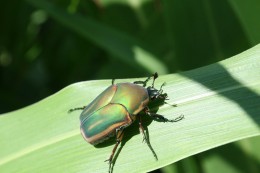— by Dr. Raymond Cloyd
Green June beetle (Cotinis nitida) adults are actively flying around and “bumping” into people and objects. Adults are 3/4 to 1.0 inches in length, and velvety-green, tinged with yellow-brown coloration (Figure 1).

Green stripes with yellow-orange margins extend lengthwise on the front wings. The underside of the body is distinctly shiny and metallic green or gold. Adults fly like “dive bombers” over turfgrass for several weeks in mid-summer. The green June beetle has a one-year life cycle, and overwinters as a mature larva (grub). Adults emerge in late-June and are active during the day, resting at night on plants or in thatch. The adults produce a sound that resembles that of bumble bees. Adults will feed on ripening fruits (Figure 2) and may occasionally feed on plant leaves.

The male beetles swarm in the morning, “dive bombing” to-and-fro above the turfgrass searching for females that are located in the turfgrass (they are desperately seeking a mate. Females emit a pheromone that attracts males. Eventually, clusters of beetles will be present on the surface of the soil or turfgrass with several males attempting to mate with a single female (I think this qualifies as an “insect orgy.” Mated females that have survived the experience lay a cluster of 10 to 30 eggs into moist soil that contains an abundance of organic matter. Eggs hatch in about 2 weeks in early August and the young larvae feed near the soil surface. The larvae feed primarily on organic matter including thatch and grass-clippings; preferring soils that are excessive moist. Larvae are 3/8 (early instars) to 1.5 (later instars) inches in length, and exhibit a strange behavioral trait—they crawl on their back (Figure 3) because that they have a constant itch.


